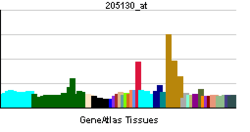RAGE (gene)
MAPK/MAK/MRK overlapping kinase is an enzyme that in humans is encoded by the RAGE gene.[3][4][5]
References
- ↑ "Human PubMed Reference:".
- ↑ "Mouse PubMed Reference:".
- ↑ Gaugler B, Brouwenstijn N, Vantomme V, Szikora JP, Van der Spek CW, Patard JJ, Boon T, Schrier P, Van den Eynde BJ (Oct 1996). "A new gene coding for an antigen recognized by autologous cytolytic T lymphocytes on a human renal carcinoma". Immunogenetics. 44 (5): 323–30. doi:10.1007/BF02602776. PMID 8781117.
- ↑ Miyata Y, Akashi M, Nishida E (May 1999). "Molecular cloning and characterization of a novel member of the MAP kinase superfamily". Genes to Cells. 4 (5): 299–309. doi:10.1046/j.1365-2443.1999.00261.x. PMID 10421840.
- ↑ "Entrez Gene: RAGE renal tumor antigen".
Further reading
- Eichmüller S, Usener D, Jochim A, Schadendorf D (August 2002). "mRNA expression of tumor-associated antigens in melanoma tissues and cell lines". Experimental Dermatology. 11 (4): 292–301. doi:10.1034/j.1600-0625.2002.110402.x. PMID 12190937.
- Götte K, Usener D, Riedel F, Hörmann K, Schadendorf D, Eichmüller S (July 2002). "Tumor-associated antigens as possible targets for immune therapy in head and neck cancer: comparative mRNA expression analysis of RAGE and GAGE genes". Acta Oto-Laryngologica. 122 (5): 546–52. doi:10.1080/00016480260092381. PMID 12206267.
- Yan M, Ghorab Z, Nadji M (June 2003). "Renal cell carcinoma antigen is expressed by yolk sac tumors and yolk sac elements of embryonal carcinomas". Applied Immunohistochemistry & Molecular Morphology. 11 (2): 113–5. doi:10.1097/00129039-200306000-00003. PMID 12777992.
- Miura J, Uchigata Y, Yamamoto Y, Takeuchi M, Sakurai S, Watanabe T, Yonekura H, Yamagishi S, Makita Z, Sato A, Omori Y, Yamamoto H, Iwamoto Y (2004). "AGE down-regulation of monocyte RAGE expression and its association with diabetic complications in type 1 diabetes". Journal of Diabetes and Its Complications. 18 (1): 53–9. doi:10.1016/S1056-8727(02)00281-7. PMID 15019601.
- Rudofsky G, Isermann B, Schilling T, Schiekofer S, Andrassy M, Schneider JG, Morcos M, Humpert PM, Sayed AA, Witte S, Renn W, Pfohl M, Hamann A, Nosikov V, Schleicher E, Häring HU, Rudofsky G, Ritz E, Nawroth PP, Bierhaus A (March 2004). "A 63bp deletion in the promoter of rage correlates with a decreased risk for nephropathy in patients with type 2 diabetes". Experimental and Clinical Endocrinology & Diabetes. 112 (3): 135–41. doi:10.1055/s-2004-817822. PMID 15052533.
- Uesaka T, Kageyama N (August 2004). "Cdx2 homeodomain protein regulates the expression of MOK, a member of the mitogen-activated protein kinase superfamily, in the intestinal epithelial cells". FEBS Letters. 573 (1-3): 147–54. doi:10.1016/j.febslet.2004.07.070. PMID 15327990.
- Bierhaus A, Haslbeck KM, Humpert PM, Liliensiek B, Dehmer T, Morcos M, Sayed AA, Andrassy M, Schiekofer S, Schneider JG, Schulz JB, Heuss D, Neundörfer B, Dierl S, Huber J, Tritschler H, Schmidt AM, Schwaninger M, Haering HU, Schleicher E, Kasper M, Stern DM, Arnold B, Nawroth PP (December 2004). "Loss of pain perception in diabetes is dependent on a receptor of the immunoglobulin superfamily". The Journal of Clinical Investigation. 114 (12): 1741–51. doi:10.1172/JCI18058. PMC 535062
 . PMID 15599399.
. PMID 15599399.
- Grunau C, Sanchez C, Ehrlich M, van der Bruggen P, Hindermann W, Rodriguez C, Krieger S, Dubeau L, Fiala E, De Sario A (May 2005). "Frequent DNA hypomethylation of human juxtacentromeric BAGE loci in cancer". Genes, Chromosomes & Cancer. 43 (1): 11–24. doi:10.1002/gcc.20155. PMID 15704127.
- dos Santos KG, Canani LH, Gross JL, Tschiedel B, Pires Souto KE, Roisenberg I (June 2005). "The -374A allele of the receptor for advanced glycation end products gene is associated with a decreased risk of ischemic heart disease in African-Brazilians with type 2 diabetes". Molecular Genetics and Metabolism. 85 (2): 149–56. doi:10.1016/j.ymgme.2005.02.010. PMID 15896660.
- Oehlrich N, Devitt G, Linnebacher M, Schwitalle Y, Grosskinski S, Stevanovic S, Zöller M (November 2005). "Generation of RAGE-1 and MAGE-9 peptide-specific cytotoxic T-lymphocyte lines for transfer in patients with renal cell carcinoma". International Journal of Cancer. 117 (2): 256–64. doi:10.1002/ijc.21200. PMID 15900605.
- Dumitriu IE, Baruah P, Bianchi ME, Manfredi AA, Rovere-Querini P (July 2005). "Requirement of HMGB1 and RAGE for the maturation of human plasmacytoid dendritic cells". European Journal of Immunology. 35 (7): 2184–90. doi:10.1002/eji.200526066. PMID 15915542.
- Haslbeck KM, Friess U, Schleicher ED, Bierhaus A, Nawroth PP, Kirchner A, Pauli E, Neundörfer B, Heuss D (September 2005). "The RAGE pathway in inflammatory myopathies and limb girdle muscular dystrophy". Acta Neuropathologica. 110 (3): 247–54. doi:10.1007/s00401-005-1043-3. PMID 15986224.
- Ramprasad S, Radha V, Mathias RA, Majumder PP, Rao MR, Rema M (March 2007). "Rage gene promoter polymorphisms and diabetic retinopathy in a clinic-based population from South India". Eye. 21 (3): 395–401. doi:10.1038/sj.eye.6702239. PMID 16440015.
- Lindholm E, Bakhtadze E, Sjögren M, Cilio CM, Agardh E, Groop L, Agardh CD (November 2006). "The -374 T/A polymorphism in the gene encoding RAGE is associated with diabetic nephropathy and retinopathy in type 1 diabetic patients". Diabetologia. 49 (11): 2745–55. doi:10.1007/s00125-006-0412-3. PMID 16969646.
- Dumitriu IE, Bianchi ME, Bacci M, Manfredi AA, Rovere-Querini P (January 2007). "The secretion of HMGB1 is required for the migration of maturing dendritic cells". Journal of Leukocyte Biology. 81 (1): 84–91. doi:10.1189/jlb.0306171. PMID 17035340.

 . PMID 15599399.
. PMID 15599399.